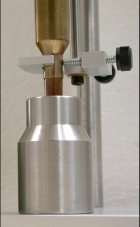The nice thing about the Larry Willis unit is that you can measure case length base to shoulder, base to ogive on a loaded round, and sort bullets ogive to ogive per se for bearing surface comparison. It is adjustable and no need to buy any extra parts or colletts except if you want to use it as a bullet comparator as shown in the picture- then you would need a Sinclair bullet comparator available in many sizes and reasonably priced. the adjustable screw allows it to adjust to most sizes in a few seconds.
The photo shows how to use a fired case secured in the unit and a bullet comparator for sorting bullets by ogive length and the neck of the bullet can be sized according to your needs for a good fit. Insert bullet in comparator, let case drop and give bullet a 1/2 turn and it repeats very well and precise. I only shoot 6mm cases and a much larger caliber may no fit for this purpose and then you would just use it as intended with the bullet oriented up and down and bullet captured by the set screw. (I like using a fired case better).
For checking base to shoulder length when setting up a resizing die using your fired case to set shoulders back a certain amount this unit really shines as you just zero it to your fired case length and work back from there.
This combined with a cheap pair of digital calipers and your ready for bear as you need calipers sometimes to measure length which the unit below can't do readily for some things.
The photo shows how to use a fired case secured in the unit and a bullet comparator for sorting bullets by ogive length and the neck of the bullet can be sized according to your needs for a good fit. Insert bullet in comparator, let case drop and give bullet a 1/2 turn and it repeats very well and precise. I only shoot 6mm cases and a much larger caliber may no fit for this purpose and then you would just use it as intended with the bullet oriented up and down and bullet captured by the set screw. (I like using a fired case better).
For checking base to shoulder length when setting up a resizing die using your fired case to set shoulders back a certain amount this unit really shines as you just zero it to your fired case length and work back from there.
This combined with a cheap pair of digital calipers and your ready for bear as you need calipers sometimes to measure length which the unit below can't do readily for some things.











